
Papal Coinage
.pdf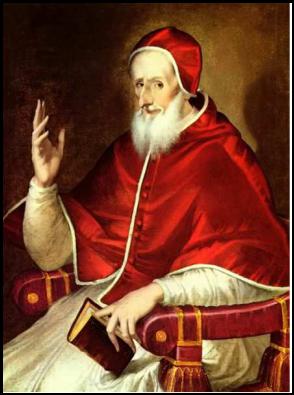
Pius V - 7 Jan. 1566 to 1 May 1572
Pope Saint Pius V, O.P. (January 17, 1504 – May 1, 1572), born Antonio Ghislieri, from 1518 called Michele Ghislieri, was Pope from 1566 to 1572 and is a saint of the Roman Catholic Church. Involved early on in the Inquisition, he resisted the influence of Protestantism throughout his papacy.
He was born as Antonio Ghislieri at Bosco in the Duchy of Milan (now Bosco Marengo in the province of Alessandria, Piedmont), Italy. At the age of fourteen he entered the Dominican Order, taking the name Michele, passing from the monastery of Voghera to that of Vigevano, and thence to Bologna. Having been ordained priest at Genoa in 1528, he was sent by his order to Pavia, where he lectured for sixteen years. He soon gave evidence of the opinions which found a more practical expression in his pontificate, by advancing at Parma thirty propositions in support of the papal chair and against the heresies of the time. As president of more than one Dominican monastery during a time of great moral laxity in the Catholic Church, he stood against the trend of the times by insisting on strict discipline, and, in accordance with his own wish to discharge the office of inquisitor, received an appointment to that post at Como. His reformist zeal provoking resentment, he was compelled in 1550 to return to Rome, where, after having been employed in several inquisitorial missions, he was elected to the commissariat of the Holy Office. Pope Paul IV (1555–59), who while still Cardinal Carafa had shown him special favor, conferred upon him the bishopric of Sutri and Nepi, the cardinalate with the title of Alessandrino, and the honor – unique in one not of pontifical rank – of the supreme inquisitorship. Under Pope Pius IV (1559–65) he became
bishop of Mondovi in Piedmont, but his opposition to that pontiff procured his dismissal from the palace and the abridgment of his authority as inquisitor.
Before Michele Ghislieri could return to his episcopate, Pope Pius IV died, and on January 7, 1566, he was elected to the papal chair as Pope Pius V with duly attendant prodigies, his coronation taking place on his birthday, ten days later. The prudence of Comniendone saved him at the commencement of his pontificate from trouble with Germany, as in the general diet of the empire at Augsburg, March 26, 1566.
Fully alive to the necessity of restoring discipline and morality at Rome to ensure success without, he at once proceeded to reduce the cost of the papal court after the manner of the Dominican Order to which he belonged, compel residence among the clergy, regulate inns, expel prostitutes, and assert the importance of the ceremonial in general and the liturgy of the Mass in particular. In his wider policy, which was characterized throughout by an effective stringency, the maintenance and increase of the efficacy of the Inquisition and the enforcement of the canons and decrees of the Council of Trent had precedence over other considerations. Accordingly, in order to implement a decision of that council, he standardized the Holy Mass by promulgating the 1570 edition of the Roman Missal. Pope Pius V made this Missal mandatory throughout the Latin rite of the Catholic Church, except where a Mass liturgy dating from before 1370 was in use. This form of the Mass remained essentially unchanged for 400 years until the modern revision of the Roman Missal in 1969/1970, after which it has become widely known as the Traditional Latin Mass; nowadays this rite, when considering the modifications made in 1960-1962 by Pope John XXIII, is known as the Extraordinary Form of the Roman Rite.
Today, Traditional Roman Catholics use either the 1962 Missal or Missals prior to changes made by Pope Pius XII in 1955 (see the General Roman Calendar as in 1954).
St Pius V recognized attacks on papal supremacy in the Catholic Church and was desirous of limiting their advancement. In France, where his influence was stronger, he took several measures to oppose the Protestant Huguenots. He directed the dismissal of Cardinal Odet de Coligny and seven bishops, nullified the royal edict tolerating the extra-mural services of the Reformers, introduced the Roman catechism, restored papal discipline, and strenuously opposed all compromise with the Huguenot nobility.
In the list of more important bulls issued by him the famous bull "In Coena Domini" (1568) takes a leading place; but amongst others throwing light on Pope Pius V's character and policy there may be mentioned his prohibition of quaestuary (February 1567 and January 1570); the condemnation of Michael Baius, the heretical Professor of Leuven (1567); the reform of the breviary (July 1568); the denunciation of the "dirum nefas" (August 1568); the banishment of the Jews from the ecclesiastical dominions except Rome and Ancona (1569); the injunction of the use of the reformed missal (July 1570); the confirmation of the privileges of the Society of Crusaders for the protection of the Inquisition (October 1570); the dogmatic certainty of the miraculous conception (November 1570); the suppression of the Fratres Humiliati for profligacy (February 1571); the approbation of the new office of the Blessed Virgin (March 1571); the enforcement of the daily recitation of the canonical hours (September 1571); and the purchase of assistance against the Turks by offers of plenary pardon (March 1572). His response to the so-called reforms of Queen Elizabeth I of England (1558–1603) included support of the imprrisoned Mary, Queen of Scots (1542–67) and her supporters in their attempts to take over England "ex turpissima muliebris libidinis servitute". An important event in the history of Elizabethan England was the publication of a bull, Regnans in Excelsis, dated April 27, 1570, that declared Elizabeth I a heretic and released her subjects from their allegiance to her. This transformed the status of persecuted English Roman Catholics from religious dissidents to potential enemies of the state.
Saint Pius V persistently and successfully attempted to form a general league against the Turks, as the result of which the Battle of Lepanto (October 7, 1571) was won by the combined fleet under Colonna. It is attested in his canonization that he miracously knew when the battle was over, himself being in Rome at the time. Three national synods were held during his pontificate at Naples under Cardinal Alfonso Caraffa (whose family had, after inquiry, been reinstated by Pius V), at Milan under Saint Charles Borromeo, and at Machim.
After his election to the papacy, Pius V continued to wear white, the color of his Dominican habit. Every Pontiff since St Pius V has followed his example of wearing white clothing. Prior to Pope Pius V, Popes, like Cardinals, wore red. This is why some papal accessories, such as the papal shoes, camauro, mozzetta, and cappello romano, are red.
Pius V died on May 1, 1572. He was succeeded by Pope Gregory XIII (1572–85). In 1696, the process of Pius's canonisation was started through the efforts of the Master of the Order of Preachers, Antonin Cloche. He also immediately commissioned a representative tomb from the sculptor Pierre Le Gros the Younger to be erected in the Sistine Chapel of the Basilica di Santa Maria Maggiore. The pope's body was placed in it in 1698. St Pius V was beatified by Pope Clement X in the year 1672, and was later canonized by Pope Clement XI (1700–21) on May 24, 1712.
Since the reform of the Roman Calendar in 1969, St Pius V's feast day was moved to April 30, the day before his death on May 1. Traditional Roman Catholics continue to commemorate Saint Pius V's feast day on May 5, deemed a III class feast (see the General Roman Calendar of 1962) or a Double feast.
Portrait of Pius V by Pierre Le GrosThe front of his tomb has a lid of gilded bronze which shows a likeness of the dead pope. Most of the time this is left open to allow the veneration of the saint's remains.
Pope St Pius V is also a Patron Saint of the Maltese Islands. He helped financially in the construction of the city of Valletta.
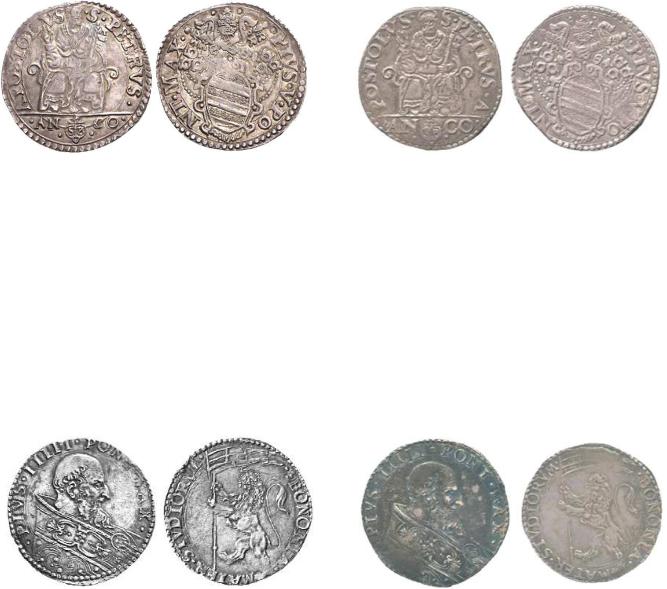
PAPAL COINS
Pius V 1566-1572.
Testone. Ancona mint.
Obv.: PIVS V PONT MAX Coat of arms surmounted by crossed keys and papal tiara.
Rev.: APOSTOLVS S PETRVS /AN {mintmark} CO in exurge. St Peter enthroned frontal, right hand raised in blessing, key in left hand, looking slightly to right.
Reference: Muntoni 34. Nice patina, VF/XF.
Estimate: 300 EUR.
PAPAL COINS
Pius V 1566-1572.
Bianco. Bologna mint. 4,85 g.
Obv.: PIVS IIIII PONT MAX Bust of pope right.
Rev.: BONONIA MATER STUDIORVM Lion standing left with banner.
Reference:Berman 1116; Munt. 49. Splendid!
Estimation CHF 200. Price realized: 425 CHF (approx. 323 U.S. Dollars as of the auction date)
PAPAL COINS
Pius V 1566-1572.
Testone. Ancona mint. 9.48 g.
Obv.: PIVS V PONT MAX Coat of arms surmounted by crossed keys and papal tiara.
Rev.: APOSTOLVS S PETRVS /AN {mintmark} CO in exurge. St Peter enthroned frontal, right hand raised in blessing, key in left hand, looking slightly to right.
Reference: (CNI 12; M 34 var; B 1105). Pleasing dark even tone and about extremely fine.
Estimate: £ 500. Price realized: 400 GBP (approx. 760 U.S. Dollars as of the auction date)
PAPAL COINS
Pius V 1566-1572.
Bianco. Bologna mint. 4,85 g.
Obv.: PIVS IIIII PONT MAX Bust of pope right.
Rev.: BONONIA MATER STUDIORVM Lion standing left with banner.
Reference: (CNI 10; M 49; B 1116). Some striking weaknesses but beautifully toned, nearly extremely fine and rare.
Estimate: £ 200. Price realized: 560 GBP (approx. 1,064 U.S. Dollars as of the auction date)
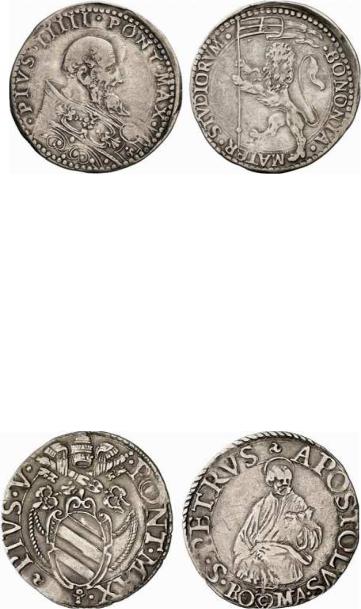
PAPAL COINS
Pius V 1566-1572.
Bianco. Bologna mint. 4,85 g.
Obv.: PIVS IIIII PONT MAX Bust of pope right.
Rev.: BONONIA MATER STUDIORVM Lion standing left with banner.
Reference: Muntoni 49. VF.
Estimate: 100 EUR. Price realized: 220 EUR (approx. 337 U.S. Dollars as of the auction date)
PAPAL COINS
Pius V 1566-1572.
Grosso. Rome mint.
Obv.: PIVS V PONT MAX Coat of arms surmounted by crossed keys and papal tiara.
Rev.: S PETRUS APOSTOLUS RO {mintmark} MA below. 3/4- length nimbate St. Peter standing frontal, holding book and key, looking to right.
Reference: Muntoni 19. Sehr schön
Estimate: 100 EUR. Price realized: 240 EUR (approx. 368 U.S. Dollars as of the auction date)
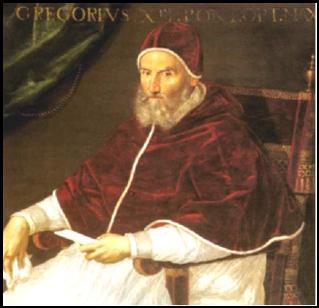
Gregory XIII - 13 May 1572 to 10 April 1585
Pope Gregory XIII (January 7, 1502 – April 10, 1585), born Ugo
Boncompagni, was Pope from 1572 to 1585.
He was born in the city of Bologna, where he studied law and graduated in 1530. Afterwards, he taught jurisprudence for some years; his students included notable figures such as Alexander Farnese, Reginald Pole and Charles Borromeo.
At the age of thirty-six he was summoned to Rome by Pope Paul III (1534–1549), under whom he held successive appointments as first judge of the capital, abbreviator, and vice-chancellor of the Campagna; by Pope Paul IV (1555–1559) he was attached as datarius to the suite of Cardinal Carafa; and by Pope Pius IV (1559–1565) he was created cardinal priest and sent to the council of Trent.
He also served as a legate to Philip II of Spain (1556–1598), being sent by the Pope to investigate the Cardinal of Toledo. It was here that he formed a lasting and close relationship with the Spanish King, which was to become a very important during his foreign policy as Pope.
Upon the death of Pope Pius V (1566–1572), the conclave chose
Cardinal Boncompagni, who assumed the name of Gregory XIII, in homage to the great reforming Pope, Gregory I (590–604), surnamed the Great. It was a very brief conclave, lasting less than 24 hours, presumed by many historians to have been due to the influence and backing of the Spanish King. His character seemed to be perfect for the needs of the church at the time. Unlike some of his predecessors, Gregory XIII was to lead a faultless personal life, becoming a model for his simplicity of life. Additionally, his legal brilliance and management abilities meant that he was able to respond and deal with the major problems quickly and decisively, although not always successfully.
Once in the chair of Saint Peter, Gregory XIII's rather worldly concerns became secondary and he dedicated himself to reform of the Catholic Church. He committed himself to putting into practice the recommendations of the Council of Trent. He allowed no exceptions for cardinals to the rule that bishops must take up residence in their sees, and designated a committee to update the Index of Forbidden Books. A new and greatly improved edition of the Corpus juris canonici was also due to his concerned patronage. In a time of considerable centralisation of power, Gregory XIII abolished the Cardinals Consistories, replacing them with Colleges, and appointing specific tasks for these colleges to work on. He was renowned for having a fierce independence; with the few confidants noting there were interventions that were not always welcomed nor advice sought for. The power of the papacy increased under him, whereas the influence and power of the Cardinals substantially decreased.
A central part of the strategy of Gregory XIII's reform was to apply the recommendations of Trent. He was a liberal patron of the recently formed Society of Jesus throughout Europe, for which he founded many new colleges. The Roman College, of the Jesuits, grew substantially under his patronage, and became the most important centre of learning in Europe for a time, a University of the Nations. It is now named the Pontifical Gregorian University. Pope Gregory XIII also founded numerous seminaries for training priests, beginning with the German College at Rome, and put them in the charge of the Jesuits. In 1575 he gave official status to the Congregation of the Oratory, a community of priests without vows, dedicated to prayer and preaching (founded by Saint Filippo Neri).
Gregory XIII is best known for his reformation of the calendar, producing the Gregorian calendar with the aid of Jesuit priest/astronomer Christopher Clavius. The reason for the reform is that the average length of the year in the Julian Calendar was too long, and the date of the actual Vernal Equinox had slowly slipped to March 10, whereas the computus (calculation) of the Easter date of Easter still followed the traditional date of March 21.
This was rectified by following the observations of Clavius and Johannes Kepler, and the calendar was changed when Pope Gregory XIII decreed that the day after October 4, 1582 would be October 15, 1582. He issued the papal bull Inter gravissimas to promulgate the new calendar on February 24, 1582. On October 15, 1582, this calendar replaced the Julian calendar, in use since 45 BC, and has become universally used today.
The switchover was bitterly opposed by much of the populace, who feared it was an attempt by landlords to cheat them out of a week and a half's rent. However, the Catholic countries of Spain, Portugal, Poland, and Italy complied. France, some states of the Dutch Republic and various Catholic states in Germany and Switzerland (both countries were religiously split) followed suit within a year or two, and Hungary followed in 1587.
Because of the Pope's decree, the reform of the Julian calendar came to be known as the Gregorian calendar. However, the rest of Europe did not follow suit for more than a century. Denmark, the remaining states of the Dutch Republic, and the Protestant states of the Holy Roman Empire and Switzerland adopted the Gregorian reform in 1700-1701. By this time, the calendar trailed the seasons by 11 days. Great Britain (and its American colonies) finally followed suit in 1752, and Wednesday, September 2, 1752 was immediately followed by Thursday, September 14, 1752; they were joined by the last Protestant holdout, Sweden, on March 1, 1753.
The Gregorian Calendar was not accepted in eastern Christendom for several hundred years, and then only as the civil calendar. The Gregorian Calendar was instituted in Russia by the communists in 1917, and the last Eastern Orthodox country to accept the calendar was Greece in 1923.
While some Eastern Orthodox national churches have accepted the Gregorian Calendar dates for "fixed" feasts (feasts that occur on the same date every year), the dates of all movable feasts (such as Easter) are still calculated in the Eastern Orthodox Churches by reference to the Julian Calendar.
Though he expressed the conventional fears of the danger from the Turks, Gregory XIII's attentions were more consistently directed to the dangers from the Protestants.
He encouraged the plans of Phillip II to dethrone Elizabeth I of England (1558–1603) thus succeeded in developing an atmosphere of subversion and imminent danger among English Protestants, who looked on any Roman Catholic as a potential traitor.
In 1578, to further the plans of exiled English and Irish catholics such as Nicholas Sanders William Cardinal Allen and James Fitzmaurice Fitzgerald, Gregory outfitted adventurer Thomas Stukeley with a ship and an army of 800 men to land in Ireland to aid in the hoped for overthrow of Elizabeth's rule through the Catholic leader and former leader of the first Desmond rebellion, Fitzmaurice. To his dismay Stukeley joined his forces with those of King Sebastian of Portugal against Emperor Abdul Malik of Morocco instead. Another papal expedition sailed to Ireland in 1579 with a mere 50 soldiers under the command of Fitzmaurice, accompanied by Sanders as papal legate. The resulting Second Desmond Rebellion was equally unsuccessful. Gregory's greatest success came in his patronage of colleges and seminaries which he founded on the Continent for the Irish and English, among others. Pope Gregory XIII had no connection with the plot of Henry, Duke of Guise, and his brother, Charles, Duke of Mayenne, to assassinate Elizabeth I in 1582, and most probably knew nothing about it beforehand.
An embarrassing moment for the Papacy was the Massacre of Huguenots in France, although it is commonly held that the Pope was ignorant of the nature of the plot at the time, having been told the Huguenots had tried to take over the government but failed. He celebrated the St. Bartholomew's Day Massacres in 1572 with a Te Deum, three frescoes depicting the events in the Sala Regia of the Vatican Palace commended to painter Giorgio Vasari and a commemorative medal, with his portrait and on the obverse a chastising angel, sword in hand and the legend UGONOTTORUM STRAGES ("Slaughter of the Huguenots ")
In Rome Gregory XIII built the magnificent Gregorian chapel in the Basilica of St. Peter, and extended the Quirinal Palace in 1580. He also turned the Baths of Diocletian into a granary in 1575.
He appointed his illegitimate son Giacomo, born to his mistress at Bologna before his papacy, castellan of St. Angelo and gonfalonier of the Church; Venice, anxious to please, enrolled him among its nobles. Philip II of Spain appointed him general in his army. Gregory also helped his son to become a powerful feudatary through the acquisition of the Duchy of Sora, on the border between the Papal States and te Kingdom of Naples.
In order to raise funds for these and similar objects, he confiscated a large proportion of the houses and properties throughout the states of the Church – a measure which enriched his treasury, indeed, for a time, but by alienating the great body of the nobility and gentry, revived old factions, created new ones, and ultimately plunged his temporal dominions into a state bordering upon anarchy. Such was the position of matters at the time of Gregory XIII's death, which took place on April 10, 1585.
Gregory XIII was succeeded by Pope Sixtus V (1585–1590).
The oldest Papal tiara still in existence dates from the reign of Gregory XIII.
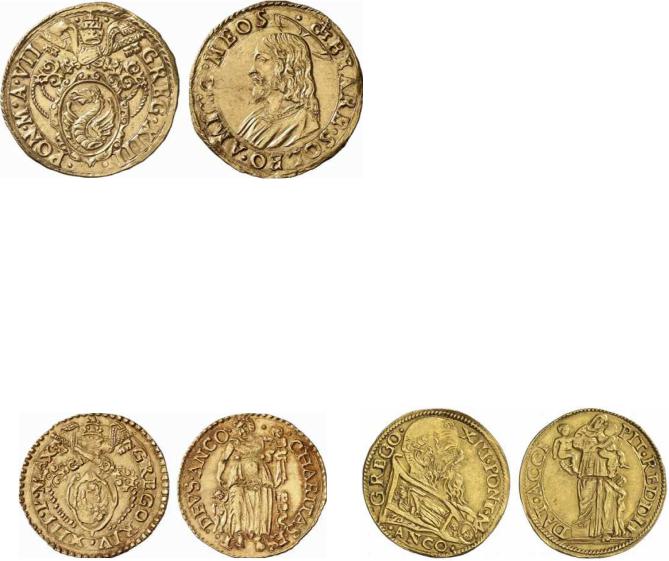
PAPAL COINS
Gregory XIII., 1572-1585.
Scudo d’oro. Ancona mint. 3,30 g.
Obv.: GREGORIV XIII P M AX Coat of arms surmounted by crossed keys and papal tiara.
Rev.: CHARITAS EX DEVS ANCO Personification of Charity frontal, with 3 children.
Reference: Fb. 312; Muntoni 181. GOLD. Extremely rare. VF/XF.
Estimate: 4000 EUR. Price realized: 6,500 EUR (approx. 9,963 U.S. Dollars as of the auction date)
PAPAL COINS
Gregory XIII., 1572-1585.
Scudo d’oro. Anno VII (1577/1578) Rome mint. 3,27 g.
Obv.: GREG XIII PONT M A VIICoat of arms surmounted by crossed keys and papal tiara.
Rev.: Bust of Christ with halo left. Legend begins with mintmark. BEARE SOLEO AMICO MEOS
Reference: Fb. 85; Muntoni 5 b. GOLD. Very rare, good XF.
Estimate: 1500 EUR. Price realized: 3,900 EUR (approx. 5,978 U.S. Dollars as of the auction date)
PAPAL COINS
Gregory XIII., 1572-1585.
Scudo d’oro. Ancona mint. 3,26 g.
Obv.: GREGO XIII PONT M Bust of pope right; ANCO beneath bust.
Rev.: DAT. ACCI – PIT . REDDIT Personification of Charity frontal, with 3 children.
Reference: Berman 1208; CNI 131; Friedberg 311; Muntoni 182. Extremely rare. XF.
Estimation CHF 8000. Price realized: 11,500 CHF (approx. 8,729 U.S. Dollars as of the auction date)
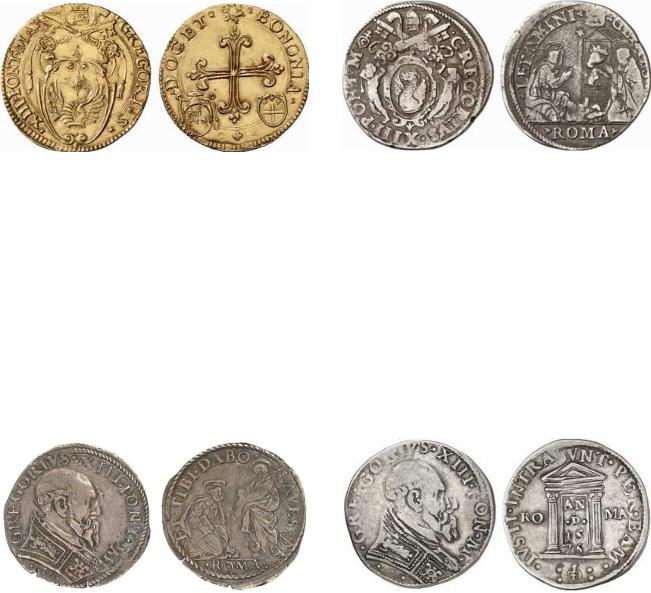
PAPAL COINS
Gregory XIII., 1572-1585.
Scudo d’oro. Bologna mint. 3,31 g.
Obv.: GREGORIVS XIII PONT MAX Coat of arms surmounted by crossed keys and papal tiara.
Rev.: Floreate cross, flanked by coats of arms at bottom. Small 4-petal rosette at bottom. DOCET BONONIA
Reference: Fb. 351; Muntoni 355. GOLD. Very rare. XF.
Estimate: 2000 EUR. Price realized: 3,600 EUR (approx. 5,518 U.S. Dollars as of the auction date)
PAPAL COINS
Gregory XIII., 1572-1585.
Testone. Rome mint.
Obv.: GREGORIVS XIII PONT M Bust of pope right.
Rev.: ET·TIBI·DABO CLAVES, Christ on right handing key to St Peter, who is kneeling and holding book at left . ROMA in exurge.
Reference: (Muntoni 22). Very fine, scarce.
Estimation: £ 60. Price realized: 120 GBP (approx. 171 U.S. Dollars as of the auction date)
PAPAL COINS
Gregory XIII., 1572-1585.
Testone. Rome mint.
Obv.: GREGORIVS XIII PONT M {mintmark} Coat of arms surmounted by crossed keys and papal tiara.
Rev.: Nativity scence with holy family, barn with cows field right, star of bethlehem above. ROMA flanked by triskeles in exurge.
Reference: Muntoni 6. Very rare, good VF.
Estimate: 500 EUR. Price realized: 1,400 EUR (approx. 2,146 U.S. Dollars as of the auction date)
PAPAL COINS
Gregory XIII., 1572-1585.
Testone. 1575 Rome mint. 31 mm 9,28 g.
Obv.: GREGORIVS XIII PONT M Bust of pope right.
Rev.: IVSTI INRABVNT PER EAM Holy Door with date on it (AN/.D./15/75); flanked by RO MA ; monogram-like mintmark in exurge.
Reference: Muntoni 29 var. Scarce, VF.
Estimate: EUR 150. Price realized: 150 EUR (approx. 223 U.S. Dollars as of the auction date)
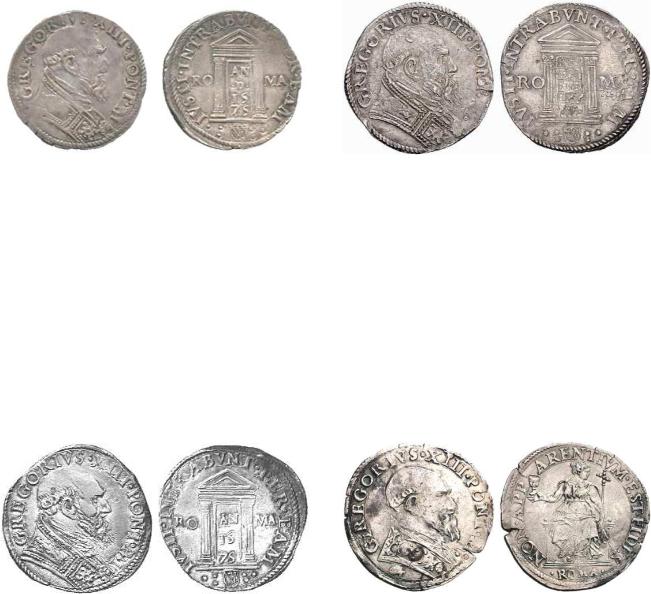
PAPAL COINS
Gregory XIII., 1572-1585.
Testone. 1575 Rome mint. 9,62 g.
Obv.: GREGORIVS XIII PONT M Bust of pope right.
Rev.: IVSTI INRABVNT PER EAM Holy Door with date on it (AN/.D./15/75); flanked by RO MA ; shield mintmark in exurge.
Reference: (CNI 26; M 29 var; B 1151). Some minor striking weakness, but with a good portrait and even toning, about extremely fine and rare.
Estimate: £ 400.
PAPAL COINS
Gregory XIII., 1572-1585.
Testone. 1575 Rome mint. 31 mm 9,37 g.
Obv.: GREGORIVS XIII PONT M Bust of pope right.
Rev.: IVSTI INRABVNT PER EAM Holy Door with date on it (AN/.15/75); flanked by RO MA ; shield mintmark in exurge.
Reference: M 33 var. I. B 1151. XF.
Estimate CHF 250. Price realized: 320 CHF (approx. 237 U.S. Dollars as of the auction date)
PAPAL COINS
Gregory XIII., 1572-1585.
Testone. 1575 Rome mint. 31 mm 9,49 g.
Obv.: GREGORIVS XIII PONT M Bust of pope right.
Rev.: IVSTI INRABVNT PER EAM Holy Door with date on it (A N / DNI / M D / LXX / V); flanked by RO MA ; shield mintmark in exurge.
Reference: CNI 49. Muntoni 33. Berman 1151. About VF.
Estimate: EUR 200. Price realized: 425 EUR (approx. 566 U.S. Dollars as of the auction date)
PAPAL COINS
Gregory XIII., 1572-1585.
Testone. Rome mint. 34 mm 9,14 g.
Obv.: GREGORIVS XIII PONT M Bust of pope right.
Rev.: NON APPARENTIVM EST FIDES Fides (Faith) seated frontal, looking to right, holding cup in right hand and cross in left hand. ROMA in exurge.
Reference: CNI 360. Muntoni 39 var. Berman 1156. Rare. Rim fracture at 4:00 o’clock. VF.
Estimate: EUR 100. Price realized: 450 EUR (approx. 668 U.S. Dollars as of the auction date)
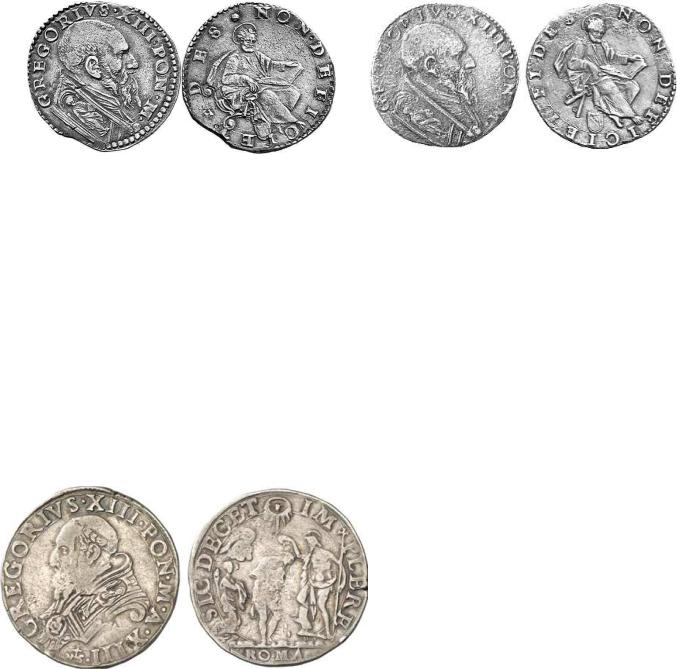
PAPAL COINS
Gregory XIII., 1572-1585.
Testone. Rome mint. 9,55 g.
Obv.: GREGORIVS XIII PONT M Bust of pope right.
Rev.: FIDES NON DEFICIET Nimbate St. Peter seated facing slightly to right, holding keys and open book, and looking down at book; below, shield.
Reference: Berman 1158. CNI XVI, p. 38, 295. Muntoni 44. Toned. Good very fine.
Estimate: CHF 300.00. Price realized: 500 CHF (approx. 333 U.S. Dollars as of the auction date)
PAPAL COINS
Gregory XIII., 1572-1585.
Testone. Rome mint. 30 mm 8,89 g.
Obv.: GREGORIVS XIII PONT M Bust of pope right.
Rev.: FIDES NON DEFICIET Nimbate St. Peter seated facing slightly to right, holding keys and open book, and looking down at book; below, shield.
Reference: M 44 var. B 1158. Rare, VF+
Estimate CHF 150. Price realized: 180 CHF (approx. 133 U.S. Dollars as of the auction date)
PAPAL COINS
Gregory XIII., 1572-1585.
Testone. Anno XIII (1584/1585) Rome mint.
Obv.: GREGORIVS XIII PONT M A XIII Bust of pope left. Mintmark below bust.
Rev.: SIC DECET IMPLERE Baptism of Christ; holy spirit above. ROMA in exurge.
Reference: Muntoni 63 b. Fast sehr schön
Estimate: 150 EUR. Price realized: 120 EUR (approx. 184 U.S. Dollars as of the auction date)
